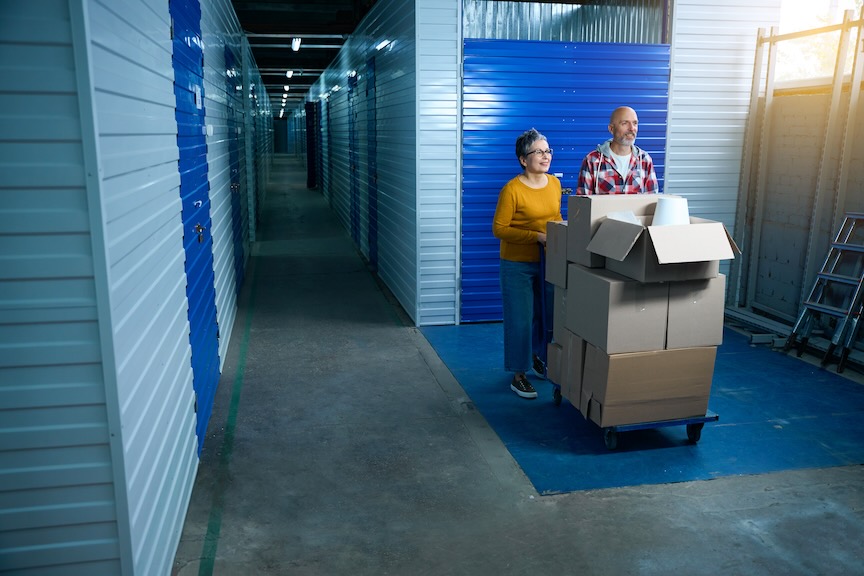A History of Self- Storage In the US
by David Branch

The concept of storage is as old as civilization itself, serving as a vital solution for keeping items that are not immediately needed but may hold future value. Storage manifests in numerous forms, from personal spaces like attics and basements to commercial warehouses for inventory management. With the advent of the digital age, the notion of storage has expanded to include hard drives, SSDs, and cloud storage, addressing our ever-growing data needs.
Throughout history, diverse cultures have devised various storage solutions. Ancient Chinese civilizations, for instance, utilized clay pots in underground vaults to safeguard valuables. Commercial storage has long played a pivotal role in trade and commerce, with warehouses and ships acting as storage facilities for goods in transit or awaiting sale.
The initial concept of self-storage emerged in the United States in the late 1800s with Bekins Van Lines. The Bekins brothers constructed the first concrete and steel warehouse for storage, pioneering modern self-storage. The contemporary self-storage industry as we recognize it today began in the United States. While the first commercial self-storage facility, "A-1 U-Store-It U-Lock-It U-Carry-the-Key," was established in Fort Lauderdale, Florida, in 1958 by the Collum family, a significant milestone in the industry occurred in 1964. In Odessa, Texas, Russ Williams and his stepson Bob Munn opened a facility named "A1 U-Store-It U-Lock-It U-Carry-the-Key." This facility, inspired by Williams' need to store his fishing equipment and boats, consisted of garage-like stalls that could be rented monthly. It introduced the novel concept of allowing renters to store their belongings, lock the unit, and keep the key themselves. Initially targeting oil field workers who required equipment storage, this facility became the prototype for the modern self-storage industry, laying the groundwork for what would evolve into a multi-billion-dollar industry in the United States.
The concept swiftly gained traction, and throughout the late 1960s and 1970s, numerous self-storage facilities sprang up across the United States. The industry experienced rapid growth due to increasing consumerism and the mobility of the American population. The boom in suburban living during the 1980s and 1990s further fueled the growth of the self-storage industry. As families moved to larger homes with more possessions, the demand for extra storage space escalated. Everytime they moved they had more and larger possessions that might not fit in their new homes.
Facilities began offering climate-controlled units to store sensitive items such as electronics, documents, and antiques. This innovation attracted more customers and diversified the types of items stored, marking a significant development in the industry.
A relatively recent entry into the storage business is Iron Storage. They have undergone years of research and development to offer the best possible service, continually improving their methods to ensure that belongings are well taken care of. Their research revealed that people seek a storage facility that is not only convenient but also affordable. Iron Storage provides a variety of storage unit sizes to fit different needs and offers competitive pricing.
Understanding the importance of security to their customers, Iron Storage has implemented state-of-the-art security features. Additionally, they offer climate-controlled units to protect belongings from environmental factors. Their facilities are located in various locations including Geneva, AL; Luverne, AL; Slocomb, AL; Brundidge, AL; Chancellor, AL; Samson, AL; Monroe, LA; Tupelo, MS; Oxford, MS; Baldwyn, MS; Canton, NC; Tulsa, OK; Holdenville, OK; Okemah, OK; Wetumka, OK; and Bacliff, TX.
At the end of 2019, there were 47,539 self-storage facilities in the United States on industrial and commercial land parcels, encompassing more than 1.9 billion square feet of available self-storage space. The six largest publicly traded storage operators, including four REITs and U-Haul, own or operate approximately 18% of these facilities. In 2020, the global industry was valued at 48.02 billion U.S. dollars.
The evolution of storage, from ancient methods to modern self-storage facilities, illustrates a continuous adaptation to meet human needs. The growth of the self-storage industry, driven by consumerism, mobility, and technological advancements, highlights its importance in contemporary society. Companies like Iron Storage exemplify how the industry continues to innovate, ensuring that storage solutions remain accessible, secure, and efficient for all.
 >
>